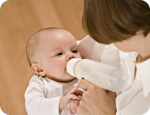From the article:
“No one is sure what is causing the change”
It is caused by substances/chemicals in our food that mimick hormones and by substances/chemicals that can trigger/force hormonal changes in the human body.
Flashback:
– The Age of Treason: 1958 Book Exposes Current Chemical Attack on Humanity
– Insider Exposed NEW WORLD ORDER Plans In 1969 (MP3 & Transcipt)
So we really know more than just one reason for this.
One reason is BPA:
– Food Industry Refuses To Take Out Harmful BPAs
– Age 10 The ‘New Norm’ For Puberty In Girls Thanks to Chemicals Like BPA:
Toxic BPA is featured in the vast majority of plastics used commercially today. This chemical has the property of mimicking estrogen when leeched into the body.
– More Than 90 Percent Of Canadians Are Contaminated With Bisphenol-A (BPA)
– Bisphenol-A (BPA) Found In Virtually All Canned Foods
From the article:
“Some parents are worried that children may be missing out on a normal childhood.”
This criminal society is not only robbing these children of a normal childhood:
– Study: BPA Leads To Birth & Fertility Defects (… And Is Linked To Diabetes & Breast Cancer)
– Red Alert For Humanity: Chemical Damage Can Be Inherited By Offspring Through Unlimited Generations
– How ‘Scientific Poisoners’ Threaten The Future Of Life On Planet Earth
– WAR ON HEALTH – The FDA’s Cult of Tyranny (Documentary):
What can you do?
– Why You Should Only Eat Organic Food

Some parents are worried that children may be missing out on a normal childhood.
– Boys are reaching puberty earlier, says study (Guardian, Oct 20, 2012):
New report by the American Academy of Paediatrics shows that boys as young as nine are showing signs of maturity
…
The study covered a large sample. It looked at more than 4,000 boys in 41 US states aged six to 16 years. Based on the so-called Tanner stages of development – a technique doctors use to measure stages of puberty – genital changes in boys started around the age of 9 or 10, and pubic hair appeared between age 10 and 11 and a half, on average.
– Onset of puberty in girls has fallen by five years since 1920 (Guardian, Oct 21, 2012):
No one is sure what is causing the change
In the late 1980s, Marcia Herman-Giddens was working in a paediatric clinic at Duke University Medical Centre in North Carolina when she noticed a puzzling phenomenon. More and more girls aged eight or nine who visited the clinic had started to sprout pubic hair and breasts. At the time, medical orthodoxy held that the average age of puberty for girls in the west was over 11. The numbers of under-10s that Herman-Giddens was seeing did not fit with this scenario. She began collecting data that eventually produced a study with the American Academy of Pediatrics that studied 17,000 girls and found that the average age of breast-budding among white girls was 9.9 years while for black girls it was 8.8.
The discovery was hugely controversial. Many doctors refused to accept the fact that more and more girls had begun to mature sexually before they had reached the age of 10. “The Lolita syndrome [the prurient fascination with the sexuality of young girls] created a lot of emotional interest,” recalls Herman-Giddens, now at the University of North Carolina. “As a feminist, I wish it didn’t.”
Today most doctors accept that the age of onset of puberty is dropping steadily. Many studies have showed this to be the case for girls, and new research carried out by Herman-Giddens, and published by the American Academy of Pediatrics, has found the same for boys. The age of onset of biological adulthood continues to plunge. Consider the statistics provided by German researchers. They found that in 1860, the average age of the onset of puberty in girls was 16.6 years. In 1920, it was 14.6; in 1950, 13.1; 1980, 12.5; and in 2010, it had dropped to 10.5. Similar sets of figures have been reported for boys, albeit with a delay of around a year.
